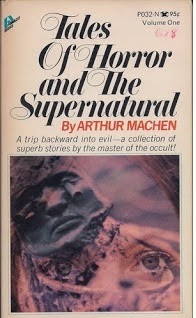Tales of Horror and the Supernatural Volume 1 by Arthur Machen, containing the following stories: "The Great God Pan", "The Inmost Light", "The Shining Pyramid", "The White People", and "The Great Return" (This edition 1948): Arthur Machen remains one of the ten or so greatest and most influential horror writers who ever lived, more than 100 years since his greatest works were published. Both scientifically inclined and mystical in nature, Machen combined these two traits in stories that expanded upon the philosophical and scientific speculations of Mary Shelley's Frankenstein.
This collection, long out of print, has been supplanted by more complete assemblies of Machen's greatest work. Nonetheless, four of the stories are among the prolific Machen's finest horror stories, while the fifth, the later "The Great Return", shows Machen's later-career move into non-horrifying Catholic mysticism.
"The Great God Pan" and "The White People" are the two titanic stories here. The first concerns a scientific experiment meant to bridge the gap between the material and immaterial world. To do so, the scientist performs a brain operation on a woman. All kinds of Hell result, though it takes decades for the full horror of the experiment to be revealed.
Collapsing the spiritual realm into the physical realm creates a being of sinister potency, and the novella explores not only the nature of evil, but what might be called the evil of nature in certain circumstances: the amoral physical universe is not something to be contemplated without some form of philosophical or ideological buffer between humanity and The Massive. Madness and self-destruction await those who confront the creature born of the experiment: traditionally, those who see the Great God Pan, die.
"The White People", framed by the drawing-room conversation of two men on the nature of true evil, is a stylistic tour-de-force. The main narrative takes the form of a teen-aged girl's journal. Educated from the age of three by a nanny who appears to practice some fairly disturbing witchcraft, the girl moves further and further into the realms of Faery -- the eponymous White People.
The journal works its horrors in a number of subtle ways. The girl's impressions of the disturbing things going on around her are those of a naive innocent, thus leaving certain surmises about what's actually happening to the reader's imagination and deductive abilities. It's brilliantly and sensitively written -- the girl is one of the most heart-breaking narrators in horror fiction by the end of the story -- and the frame narrative, with her story recollected in tranquility, adds an extra layer of verisimilitude and philosophical depth.
Added to these things is a trope that writers such as H.P. Lovecraft would explore more fully -- the story repeatedly refers to rituals and concepts without ever explaining what they truly are. Terms such as 'Aklo' and 'voorish' and 'dhols' would show up in the work of other writers, as would the overall concept of fictional rituals and terms. The great T.E.D. Klein would go so far as to posit "The White People" as a dangerous supernatural text in its own right in his sublime 1984 novel The Ceremonies. There are the White Ceremonies, the Green Ceremonies, and the Scarlet Ceremonies...
Besides the joyful "The Great Return," in which the Holy Grail brings hope to the Welsh during World War One, we also get "The Shining Pyramid," with sinister doings in the countryside and sinister hidden races, and "The Inmost Light," which works as a companion piece to "The Great God Pan." Machen's potent combination of cosmic musings, philosophical enquiry, and mythologies both real and fictional would show the way for many writers to follow. H.P. Lovecraft and his 'disciples' would owe a lot to Machen, and Lovecraft himself praised Machen's work extravagantly in his essay "Supernatural Horror in Literature." He's an indispensable part of the history of horror literature. Because sometimes you really don't want to know what a "wicked voorish dome in Deep Dendo" is, yet you sort of do. Highly recommended.

No comments:
Post a Comment
Note: Only a member of this blog may post a comment.